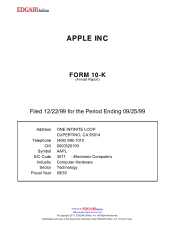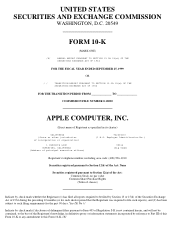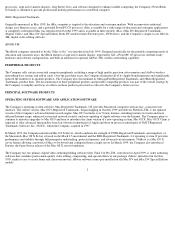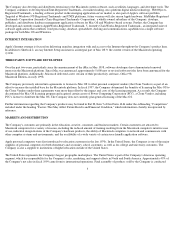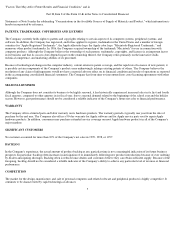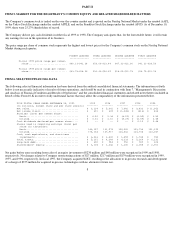Apple 1999 Annual Report Download - page 6
Download and view the complete annual report
Please find page 6 of the 1999 Apple annual report below. You can navigate through the pages in the report by either clicking on the pages listed below, or by using the keyword search tool below to find specific information within the annual report.The Company also develops and distributes extensions to the Macintosh system software, such as utilities, languages, and developer tools. The
Company continues to develop QuickTime-Registered Trademark-, its market-leading cross platform digital media technology. WebObjects-
Registered Trademark-, a leading software product in the emerging application server market, is also part of Apple's software portfolio.
Targeted at Windows NT-Registered Trademark- and UNIX platforms, future versions will also run on Apple hardware. FileMaker-Registered
Trademark- Corporation (formerly Claris-Registered Trademark- Corporation), a wholly owned subsidiary of the Company, develops,
publishes, and distributes database management application software for Mac OS and Windows-based systems. Further, the Company has
developed and currently markets AppleWorks-Registered Trademark- 5, formerly ClarisWorks-Registered Trademark-, an integrated suite of
software applications that combines word processing, database, spreadsheet, drawing and communications capabilities in a single software
package for both Mac OS and Windows.
INTERNET INTEGRATION
Apple's Internet strategy is focused on delivering seamless integration with and access to the Internet throughout the Company's product lines.
In addition to Sherlock 2, an easy Internet Setup Assistant is an integral part of Mac OS 9, the current version of the Macintosh operating
system.
THIRD PARTY SOFTWARE DEVELOPERS
Over the past two years, particularly since the announcement of the iMac in May 1998, software developers have demonstrated renewed
interest in the Macintosh platform. Since iMac was announced, approximately 5,000 new or revised software titles have been announced for the
Macintosh platform. Additionally, Microsoft delivered a new version of their productivity software--Office 98:
Macintosh Edition--in early 1998.
The Company previously entered into agreements to license its Mac OS to other personal computer vendors (the Clone Vendors) as part of an
effort to increase the installed base for the Macintosh platform. In fiscal 1997, the Company determined the benefits of licensing the Mac OS to
the Clone Vendors under these agreements were more than offset by the impact and costs of the licensing program. As a result, the Company
discontinued the Mac OS licensing program and acquired certain assets of Power Computing Corporation (PCC), a Clone Vendor, including
PCC's license to distribute the Mac OS. The Company does not currently plan general licensing of the Mac OS.
Further information regarding the Company's products may be found in Part II, Item 7 of this Form 10-K under the subheading "Competition"
included under the heading "Factors That May Affect Future Results and Financial Condition," which information is hereby incorporated by
reference.
MARKETS AND DISTRIBUTION
The Company's customers are primarily in the education, creative, consumer, and business markets. Certain customers are attracted to
Macintosh computers for a variety of reasons, including the reduced amount of training resulting from the Macintosh computer's intuitive ease
of use, industrial design features of the Company's hardware products, the ability of Macintosh computers to network and communicate with
other computer systems and environments, and the availability of a wide variety of certain user-friendly application software.
Apple personal computers were first introduced to education customers in the late 1970s. In the United States, the Company is one of the major
suppliers of personal computers for both elementary and secondary school customers, as well as for college and university customers. The
Company is also a supplier to institutions of higher education outside of the United States.
The United States represents the Company's largest geographic marketplace. The United States is part of the Company's Americas operating
segment, which has responsibility for the Company's sales, marketing, and support efforts in North and South America. Approximately 45% of
the Company's net sales in fiscal 1999 came from its international operations. Final assembly of products sold by the Company is conducted
3

